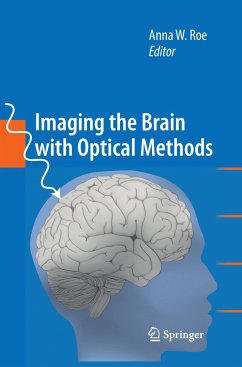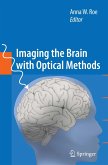Monitoring brain function with light in vivo has become a reality. The technology 33 of detecting and interpreting patterns of reflected light has reached a degree of 34 maturity that now permits high spatial and temporal resolution visualization at both 35 the systems and cellular levels. There now exist several optical imaging methodolo- 36 gies, based on either hemodynamic changes in nervous tissue or neurally induced 37 light scattering changes, that can be used to measure ongoing activity in the brain. 38 These include the techniques of intrinsic signal optical imaging, near-infrared optical 39 imaging, fast optical imaging based on scattered light, optical imaging with voltage 40 sensitive dyes, and two-photon imaging of hemodynamic signals. The purpose of 41 this volume is to capture some of the latest applications of these methodologies to 42 the study of cerebral cortical function. 43 This volume begins with an overview and history of optical imaging and its use 44 in the study of brain function. Several chapters are devoted to the method of intrin- 45 sic signal optical imaging, a method used to record the minute changes in optical 46 absorption due to hemodynamic changes that accompanies cortical activity. Since the 47 detected hemodynamic changes are highly localized, this method has excellent 48 spatial resolution (50-100 µm ), a resolution sufficient for visualization of fundamen- 49 tal modules of cerebral cortical function.
"This is an excellent textbook of optical imaging techniques exploring cerebral cortical physiology using fMRI, OCT, and voltage-sensitive dyes. ... The book is well suited for neurophysiology students, fellows, and researchers. ... I highly recommend this book for all neurophysiology investigators." (Joseph J. Grenier, Amazon.com, April, 2015)
"This volume is a good overview of the many uses of optical imaging to explore brain function. A wide range of methodologies discussed, and the techniques address research questions at different 'levels of organization' ... . It is therefore likely that individual scientists will find ... chapters directly relevant to their direct interests. ... Overall, this book contains very useful basic level reviews, other chapters cover systems-level and modality-specific ... techniques. The volume does cover an interesting range of optical methods." (Robert V. Harrison, Canadian Journal of Neurological Sciences, Vol. 37 (5), September, 2010)
"This volume is a good overview of the many uses of optical imaging to explore brain function. A wide range of methodologies discussed, and the techniques address research questions at different 'levels of organization' ... . It is therefore likely that individual scientists will find ... chapters directly relevant to their direct interests. ... Overall, this book contains very useful basic level reviews, other chapters cover systems-level and modality-specific ... techniques. The volume does cover an interesting range of optical methods." (Robert V. Harrison, Canadian Journal of Neurological Sciences, Vol. 37 (5), September, 2010)









